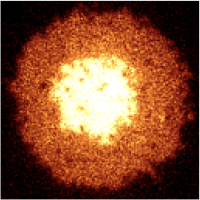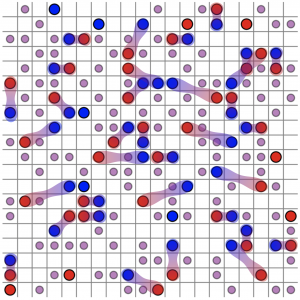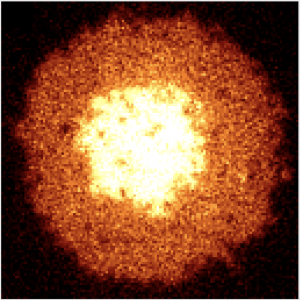- Direct observation of non-local fermion pairing in an attractive Fermi-Hubbard gas (10/11/2022)
Thomas Hartke, Botond Oreg, Carter Turnbaugh, Ningyuan Jia, Martin Zwierlein
Pairing of fermions lies at the heart of superconductivity, the hierarchy of nuclear binding energies and superfluidity of neutron stars. The Hubbard model of attractively interacting fermions provides a paradigmatic setting for fermion pairing, featuring a crossover between Bose-Einstein condensation (BEC) of tightly bound pairs and Bardeen-Cooper-Schrieffer (BCS) superfluidity of long-range Cooper pairs, and a “pseudo-gap” region where pairs form already above the superfluid critical temperature. We here directly observe the non-local nature of fermion pairing in a Hubbard lattice gas, employing spin- and density-resolved imaging of ∼1000 fermionic 40K atoms under a bilayer microscope. Complete fermion pairing is revealed by the vanishing of global spin fluctuations with increasing attraction. In the strongly correlated regime, the fermion pair size is found to be on the order of the average interparticle spacing. We resolve polaronic correlations around individual spins, resulting from the interplay of non-local pair fluctuations and charge-density-wave order. Our techniques open the door toward in-situ observation of fermionic superfluids in a Hubbard lattice gas.
- Quantum Register of Fermion Pairs (1/26/2022)
Thomas Hartke, Botond Oreg, Ningyuan Jia, Martin W. Zwierlein
Nature 601, 537–541 (2022). download
featured in MIT News
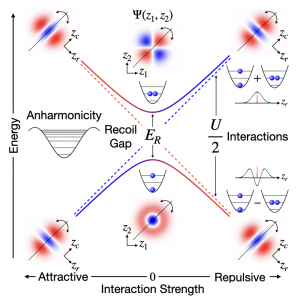
Fermions are the building blocks of matter, forming atoms and nuclei, complex materials and neutron stars. Our understanding of many-fermion systems is however limited, as classical computers are often insufficient to handle the intricate interplay of the Pauli principle with strong interactions. Quantum simulators based on ultracold fermionic atoms instead directly realize paradigmatic Fermi systems, albeit in “analog” fashion, without coherent control of individual fermions. Digital qubit-based quantum computation of fermion models, on the other hand, faces significant challenges in implementing fermionic anti-symmetrization, calling for an architecture that natively employs fermions as the fundamental unit. Here we demonstrate a robust quantum register composed of hundreds of fermionic atom pairs trapped in an optical lattice. With each fermion pair forming a spin-singlet, the qubit is realized as a set of near-degenerate, symmetry-protected two-particle wavefunctions describing common and relative motion. Degeneracy is lifted by the atomic recoil energy, only dependent on mass and lattice wavelength, thereby rendering two-fermion motional qubits insensitive against noise of the confining potential. We observe quantum coherence beyond ten seconds. Universal control is provided by modulating interactions between the atoms. Via state-dependent, coherent conversion of free atom pairs into tightly bound molecules, we tune the speed of motional entanglement over three orders of magnitude, yielding 10^4 Ramsey oscillations within the coherence time. For site-resolved motional state readout, fermion pairs are coherently split into a double well, creating entangled Bell pairs. The methods presented here open the door towards fully programmable quantum simulation and digital quantum computation based on fermions.
- Doublon-Hole Correlations and Fluctuation Thermometry in a Fermi-Hubbard Gas (3/25/2020)
Thomas Hartke, Botond Oreg, Ningyuan Jia, Martin Zwierlein
Phys. Rev. Lett. 125, 113601 (2020)
DOI:10.1103/PhysRevLett.125.113601
We report on the single atom and single site-resolved detection of the total density in a cold atom realization of the 2D Fermi-Hubbard model. Fluorescence imaging of doublons is achieved by splitting each lattice site into a double well, thereby separating atom pairs. Full density readout yields a direct measurement of the equation of state, including direct thermometry via the fluctuation-dissipation theorem. Site-resolved density correlations reveal the Pauli hole at low filling, and strong doublon-hole correlations near half filling. These are shown to account for the difference between local and non-local density fluctuations in the Mott insulator. Our technique enables the study of atom-resolved charge transport in the Fermi-Hubbard model, the site-resolved observation of molecules, and the creation of bilayer Fermi-Hubbard systems.
- Congratulations to Dr. Lawrence Cheuk on his Assistant Professorship at Princeton University (4/12/2019)
We wish Lawrence success and wonderful discoveries with his new research group!
Check out his homepage: https://sites.google.com/view/cheuk-lab/home
- Spin Transport in a Mott Insulator of Ultracold Fermions (12/6/2018)
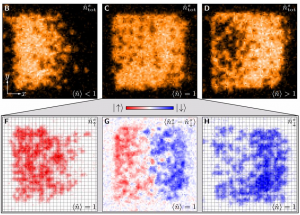 Matthew A. Nichols, Lawrence W. Cheuk, Melih Okan, Thomas R. Hartke, Enrique Mendez, T. Senthil, Ehsan Khatami, Hao Zhang, Martin W. Zwierlein
Matthew A. Nichols, Lawrence W. Cheuk, Melih Okan, Thomas R. Hartke, Enrique Mendez, T. Senthil, Ehsan Khatami, Hao Zhang, Martin W. Zwierlein
Science, 363, 383 (2019)Science Perspective by Jean-Philippe Brantut, EPFL Lausanne
MIT News Article by Helen Knight
Strongly correlated materials are expected to feature unconventional transport properties, where charge, spin, and heat conduction are potentially independent probes of the dynamics. In contrast to charge transport, the measurement of spin transport in such materials is highly challenging. Here we observe spin conduction and diffusion in a system of ultracold fermionic atoms that realizes the half-filled Fermi-Hubbard model. For strong interactions, spin diffusion is driven by super-exchange and doublon-hole-assisted tunneling, and strongly violates the quantum limit of charge diffusion. The technique developed in this work can be extended to finite doping, which can shed light on the complex interplay between spin and charge in the Hubbard model.
- Spatial Charge and Spin Correlations in the 2D Fermi-Hubbard Model (6/13/2016)

Lawrence W. Cheuk, Matthew A. Nichols, Katherine R. Lawrence, Melih Okan, Hao Zhang, Ehsan Khatami, Nandini Trivedi, Thereza Paiva, Marcos Rigol, Martin W. Zwierlein Science 353, 1260-1264 (2016), arXiv:1606.04089
Strong electron correlations lie at the origin of transformative phenomena such as colossal magneto-resistance and high-temperature superconductivity. Already near room temperature, doped copper oxide materials display remarkable features such as a pseudo-gap and a “strange metal” phase with unusual transport properties. The essence of this physics is believed to be captured by the Fermi-Hubbard model of repulsively interacting, itinerant fermions on a lattice. Here we report on the site-resolved observation of charge and spin correlations in the two-dimensional (2D) Fermi-Hubbard model realized with ultracold atoms. Antiferromagnetic spin correlations are maximal at half-filling and weaken monotonically upon doping. Correlations between singly charged sites are negative at large doping, revealing the Pauli and correlation hole\textemdash a suppressed probability of finding two fermions near each other. However, as the doping is reduced below a critical value, correlations between such local magnetic moments become positive, signaling strong bunching of doublons and holes. Excellent agreement with numerical linked-cluster expansion (NLCE) and determinantal quantum Monte Carlo (DQMC) calculations is found. Positive non-local moment correlations directly imply potential energy fluctuations due to doublon-hole pairs, which should play an important role for transport in the Fermi-Hubbard model.
- Observation of 2D Fermionic Mott Insulators (4/1/2016)

Lawrence W. Cheuk, Matthew A. Nichols, Katherine R. Lawrence, Melih Okan, Hao Zhang, Martin W. Zwierlein Phys. Rev. Lett. 116, 235301 (2016); arXiv:1604.00096 (2016)
We report on the site-resolved observation of characteristic states of the two-dimensional repulsive Fermi-Hubbard model, using ultracold 40K atoms in an optical lattice. By varying the tunneling, interaction strength, and external confinement, we realize metallic, Mott-insulating, and band-insulating states. We directly measure the local moment, which quantifies the degree of on-site magnetization, as a function of temperature and chemical potential. Entropies per particle as low as 0.99(6)kB indicate that nearest-neighbor antiferromagnetic correlations should be detectable using spin-sensitive imaging.
